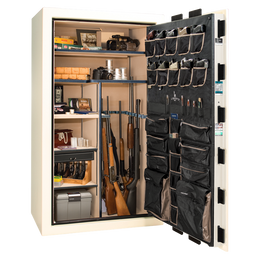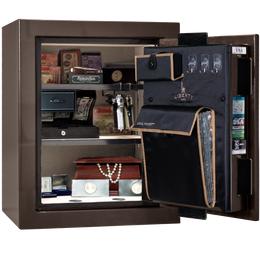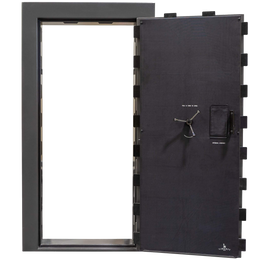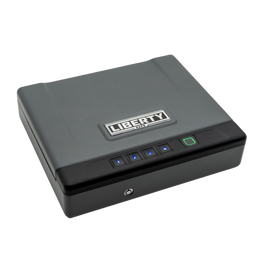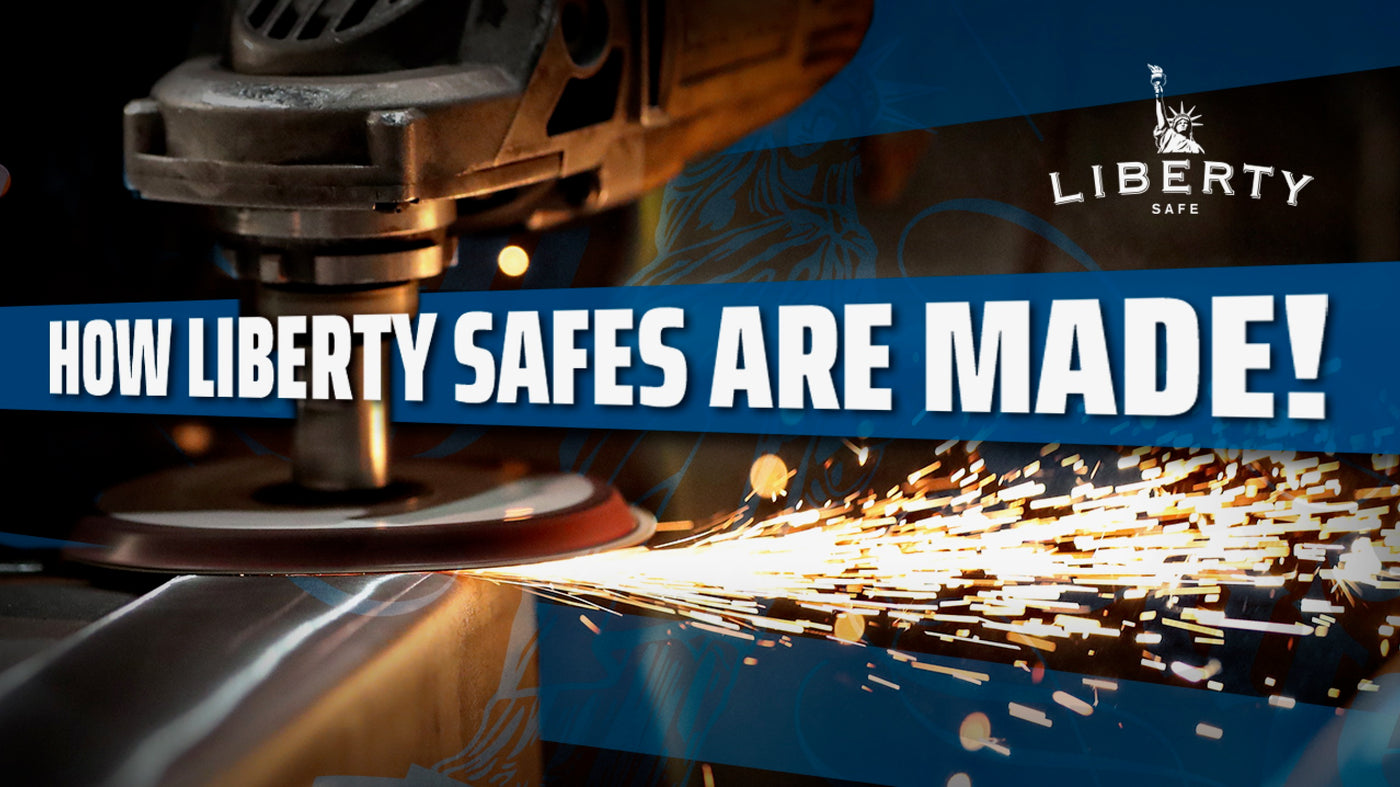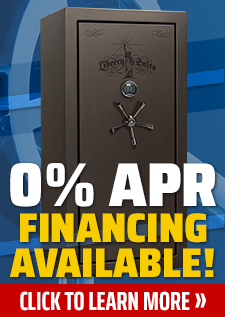A Guided Tour Through the Liberty Safe Factory (8:35)
Home and gun safes from Liberty are better because we build them better.
Our facility is the most technologically advanced safe manufacturing plant in the nation. We only use American-made pickled and oiled steel. We use rollform technology to build our trademark two-piece safe bodies. We use military-style locking bars for added security. And, of course, our gun safes are made in the USA.
Let’s see how it’s all done.
Raw Materials
The first step in building a Liberty Safe is bringing in the materials. We use all US-made steel. All of our steel is hot-rolled P&O steel. P&O stands for pickled and oiled, which is an older term that means the steel is etched with acid to get rid of any rust (pickled), and then the steel is oiled to make sure it lasts.
Trucks are delivering this steel to our facilities twice a day, which is important because we’re building around 700 safes per day.
Each steel roll is assigned and labeled for specific lines of safes to keep everything organized. The steel rolls will be decoiled and shaped into the body of the safe, and the back and door of the safe will come in as flat sheets of steel.
Decoiling & Shaping Steel
In this next phase of the process, the rolled steel is decoiled and shaped into the body of the safe. We’ll place the roll of steel into a decoiling machine that will flatten the sheet and punch it out. Punching it out simply means that the steel is cut and prepped to become the body of the safe.
We use roll-forming to help give the metal its shape, and then it goes into a wing bender machine that will bend the metal sheet to form the sides of the safe.
Liberty Safes’ strength comes partially from a safe that is made from only two pieces of steel: the box and the back. Two-piece safe body construction is the closest we can get to constructing a safe from a single piece of metal. Having fewer pieces allows the safe to withstand more punishment and be more resistant to pry attacks.
Initial Assembly
Now is where our hand processes really start. During the initial assembly, welders will tack the safe back onto the body of the safe. Then we utilize robot technology to weld the back completely in place, giving it a consistent, perfect weld every time. This single-bead weld only takes a few seconds. This is when the product really starts to look like a safe.
After this our grinders get to work to clean up the corner welds and any spatter. They’ll grind away nicks and imperfections to bring the quality that we aim for in every one of our products.
While the safes are being grinded for top-quality, welders will attach the safe’s front door. We have to make sure it is spaced just right and then lock it into place with heavy-duty welds.
Quality Control Check
Quality is everything, so we make sure to have plenty of checks along the way. Our first big quality control check takes place once the safe is assembled. We’ll check all the welds to make sure they look clean and smooth and also clean out the boxes, checking for any debris or dust to ensure they are good moving forward into the next phases of the manufacturing process.
Rinsing & Painting
Once the safes have been inspected and cleared for the next steps in the process, they are moved to an area for rinsing and painting.
First, they are rinsed off, then etched with a chemical, and then rinsed off a couple more times to ensure they are perfectly clean and ready to be painted.
In the paint room, safes are constantly being fed down a conveyor to get painted. During this process, little paint particles are electronically charged and the safe is grounded. This is important because it allows the paint particles to take hold on the surface of the safe like a magnet when they are sprayed on.
Next, the safes are slowly ran through a two-stage oven. The infrared sets off the geling process, and then a convection oven cures the coating over a 30-45 minute cycle. You can see the paint get shiny as it starts to melt and gel.
Once the painting process is done, that's when the logos are manually painted onto each safe, including a section that says “Made in the U.S.A.” Liberty is proud to have American-made products and we display the American flag with the same pride throughout our production facilities.
Main Assembly: Fire Protection & Security
Now it’s time for the pieces that give Liberty Safes the layers of protection and security that we value in each safe.
Fireboard
Fireboard lines the inside of each Liberty Safe to ensure protection against heat and fire. The more fireboards that are added, the hire the fire rating.
We use giant waterjet lasers to cut layers of fireboard to line our safes. After the fireboard is cut into the right shape, they are glued together and into the safes.
Military-style Locking Bars
Traditionally, safes use round pin locking bolts to hold the safe securely shut. At Liberty Safe, we use our own military-style locking bars instead. These locking bars provide more security against pry attacks because they cover more surface area and go deeper into the safe’s body than round pins do. This makes it almost impossible to pry open safes equipped with these bars.
Lock
Liberty Safes can come with a mechanical or electronic lock (or sometimes both). Most people opt for electronic/digital locks for ease of use.
Digital locks have come a long way and are very reliable. Our digital locks are EMP-resistant to help provide you with the top-security features on the market.
Palusol™
We include another layer or fire and heat protection with a Palusol™ fire seal. This seal expands to 7 times its size when it reaches 212 degrees Fahrenheit, sealing off both heat and smoke from the inside of the safe.
Palusol™ is such an effective seal because it maintains its expanded form even when temperatures reach over 1200 degrees, while other seals that we’ve tested tend to fall apart and let the heat in at that point.
Building Safe Interior
Our safes wouldn’t be the top-quality products that they are without a beautifully finished interior. Our team hand steams the safe door sleeves to remove wrinkles. These are the pockets that allow you to place more items in your safe door.
Our workers also staple the interior fabrics and trims to all of the interior walls, shelves, and gun racks, ensuring a perfect finish in every safe.
At this point we’ll also add the handle to the outside of the safe and assemble the interior shelving and dividers.
Final Inspection
Each Liberty Safe wouldn’t be complete without a final inspection to ensure the best quality possible. During this final quality check our team will look for:
- Flaws in the paint
- Flaws in the box itself
- Working locks
- Working mechanism
- Overall quality, look, and functionality of the safe
After this final inspection, each safe goes right into a bag and box for shipping and is ready for distribution.
Research & Development
We have done extensive testing on our products to ensure their quality and protection. You may have even seen some of our videos.
Our team has tested our safes against competitor safes by dropping our safes from extreme heights, dropping thousand pound blocks of cement on the safes, and even blowing them up with dynamite to prove that the structural integrity of Liberty Safes is much more superior to our competitors.
Take a look at some of our videos:
- 500' Helicopter Drop, Plus Explosives! Our Toughest Gun Safe Test Yet
- Torture Test: Safe vs. Flamethrower
- Dynamite Verses Gun Safes
Ready to bring a Liberty Safe into your home? Get started with our “Which Safe is Right For You?” quiz to find the perfect Liberty Safe for you.
Watch the Full Version Here
An Extended Tour of Liberty Safes Factory (20:54)
On today's show, sparks fly as workers shape steel into solid boxes of security. The end result of all this work, worthy of some serious R&D. Today we blow open the story behind Liberty Safes.
People are passionate about outdoor equipment. Get this, Americans spend more than twenty billion dollars a year on gear but no one ever really sees how their stuff gets made. Well, that's where we come in. Each week we throw open the factory doors and give you a behind-the-scenes look at how your favorite gear is made.
Maple Grove Lock & Safe sure seems to sell a lot of safes these days. Look at that–sold, sold and sold. You know they’ve become pretty popular for folks who like to store guns and ammo and even family valuables or heirlooms.
Liberty Safe seems to be the choice. I think you'll understand why when you see how these safes get made for the outdoors.
Payson, Utah
Stark mountain peaks line Utah's Valley. The town of Payson sits tucked right up against the Wasatch Range. Just on the edge of the mountains this larger-than-life complex, home to an absolutely iconic US brand.
Liberty Safes, a business close to three decades old. This business started in storage units. Basically they were just doing maybe one safe every two days. The facility has grown from two or three small factories into this large factory that's 320,000 square feet.
CEO Steve Allred offered us a peek behind Liberty's closed doors to better understand Liberty's production process. It all starts over by the loading docks.
Raw Materials
The entire process starts right here. Two times a day, the trucks are delivering all-us-made steel; what they call hot-rolled P&O steel. P&O stands for pickled and oiled. It’s an old phrase, but all it means is this stuff is etched with acid to get rid of the rust and then it's oil to make sure it's good forever.
Each 14,000-pound roll sits labeled for specific lines of safes. Safe doors and backs come in as flat sheets.
De-coiling Steel
Sean Woolstenhume winds steal off the roll and threads it through a de-coiling machine.
Sean: We straighten it out to a flat sheet. Then from there, we take the coil or the flat sheet and punch it out.
To punch it out means to cut and prep the metal to become the body of the safe; safes darn near every employee around here believe in.
Interviewer: I’ve got to ask you, do you own a Liberty Safe?
Sean: I own two.
Interviewer: Of course he does.
This line (punch station line) is where 70% of Liberty Safes come to life. It’s incredible when you think about the amount of pressure it must take to shape.
Forming Metal
Now, the flattened and prepped steel enters what engineers call roll forming. It's a little bit tricky to see what's going on in there, but essentially, this machine is taking that flat steel and it's starting to shape the sides of the safe; and you can see what it looks like when it pops out on that far end.
The sheet pops out ready to take shape, literally.
Employee: We’ll then move over into our wing bender which will bend the sides of the box up into the box shape.
Liberty Safe's strength comes partially from a safe box made only of two pieces of steel: the box and the back.
After we go through the wing bender, that’s where our hand process really starts.
Initial Assembly
Welders first tack the back on to the safe. They weld just enough to hold the steel plate in place.
Brad Higginson: It's really important in that process because they are tacking the back on so the robots can understand and know what to weld.
Interviewer: Ah yes, the robot. I named it Libertron.
Brad: Robots can give you a really consistent, really perfect weld every time. It's really pretty; we don’t even grind the weld, it's so pretty.
It takes just a few seconds to complete the single-bead weld. When the robot’s done with them, they start to look like safes.
Now it's time to clean them up a little bit. Grinders get to work. They clean up the corner welds and any spatter. While they grind away the day, a high-powered laser cuts doors to shape.
Now, welders attach the safe’s front door. They space it just right and lock it into place with heavy-duty welds.
We’ve got quality people working for a quality company and that’s why we’ve got some of the best products. It's what makes Liberty Safe who they are.
Jake Farley preps a pile of safes in a single shift.
Jake: I'd say anywhere from 140 to 175 (safes in a shift). I've been here a while and a lot of it is you're used to it.
Interviewer: Oh, it's more than that.
Jake: Absolutely, I put a lot of hard work into these.
Interviewer: Okay, while Jake keeps cranking out safes, I'll take a quick break. When we come back–an eternal March as Liberty safes earn their colors.
Under the watchful peaks of Utah's Wasatch Mountains, Liberty cranks out high-security safes. With the safe boxes now built and doors attached, Jake Farley's crew preps safes.
Jake: We get all the nicks out of it–we grind it out. Whatever gets welded together, we grind it down and make it quality and send it onto paint.
But not before Wes Condor takes a peek. Quality control double checks all the welds and cleans out the boxes–so important for the safe’s next few hours.
Rinse & Paint
Any good safe deserves a wash. Think of this area as the biggest shower you've ever seen. Once they're ready to go, they need to be rinsed off. They get etched with a chemical and then rinse a couple of times. Now they're ready to earn their colors.
In here, the paint room, where an eternal march of safes moves down the slowly creeping conveyor. It is such a cool process to watch, but there's more to this story than what you might see; let me explain.
Those little paint particles, they're actually electrically charged and the safe is grounded so that when the nozzles spray, all those particles absolutely stick like a magnet.
The safes now, ever so slowly, run through a two-stage oven. The infrared sets off the gelling process and then a convection oven is what cures it out over a 30 to 45-minute cycle. You can literally see the paint get shiny as it starts to melt and gel.
Let's sneak next door while the paint takes a little time to cure.
Prepping Fireboard
Interviewer: By the way, just in case you're wondering how much fireboard Liberty goes through. See these two giant piles behind me, that's the stash for today's work–one day.
The fire board, the work of Anthony Sullivan, the guy who preps fire protection.
That giant water jet cuts layers of fire board for each of the safes. This material is much like drywall with higher moisture content. Anthony separates finished pieces from the scrap.
Quality Control & Logos
Now, painted safes slowly march out of the oven. Another quick QC check and then Zack Byars gets his hands on each safe.
Zach wipes Liberty's logo on to each safe. Liberty, not just a name, but a belief among these people.
Zach: Yeah, overall there's a lot of pride that we’re made in the USA.
Suppose that's why the American flag decorates the production facility. We find them all over. A simple, yet profound gesture and part of the reason company's CEO Steve Allred suggested Liberty install another production line made up of robots.
Steve Allred: My passion is to bring jobs back to the US and build the product. And you think about automation, instead of reducing jobs, we increased over 80 jobs back in the US. Our employees are basically the key assets to the success of our business.
You better understand, back over on the high-volume line where people work hard, with paint and logos dried, main assembly starts. Every single one of the safes gets one of these little boxes. This is like the recipe sheet. These are the instructions so they know exactly what's going into the individual safe.
Chasse Henriksen: This is where we installed a fire board to give us what fire rating each safe will need.
The more fire board workers add, the higher the fire rating. Now safe from heat, Liberty adds another layer of protection.
Installing Locking Bars Onto Safe
They're getting ready to install these locking bars into the door of the safe.
Traditionally, safes were locked with round pins–but Liberty engineers discovered a better mousetrap…of sorts.
Kyle Clouse: This is our latest greatest. This is patent-pending military-style locking bars, and the difference between these and the round pins is–obviously–you can see that you have more surface coverage; so that it grabs the safe and protects it against a pry attack.
Question is–just how do you figure that out?
Well up next, we'll show you a tease. It takes a few sticks of dynamite and a real appetite for destruction.
Research & Development
Liberty Safes–simply stated they are steel boxes built to protect stuff. No secret Liberty prides itself on quality, so much so this company decided to have a little fun–and maybe, just maybe prove a point.
Steve: Basically 60% stronger than most safes, and you can see it on our videos.
Ah yes, the videos–Liberty’s version of R&D, like that one time they tried to blow up their safes with dynamite.
Kyle: We’ve put dynamite inside our safes. We've dropped thousand pound blocks of cement onto our safes. What we're proving is that the structural integrity of a Liberty Safe is much more superior than the competitors.
And you guys have fun, too.
Steve: Not my favorite thing in the world, but I love the impact that it has to the company. But I hate destroying the products that we build. It proved that they're stronger than even what we did when we designed them.
Prettier, too!
With boxes built, painted, and now protected from fire, it's time to lock them up.
Adding The Lock
You can get a safe with either a mechanical lock or a push button. Turns out a lot more people now choose digital versus mechanical.
Kyle: Digital locks have come so far that they're very reliable. In fact, we get comments from people asking: Well in the event of an EMP, is my digital lock still going to work? And they are EMP-resistant.
Palusol Heat Protectant
Another piece of the security puzzle goes right along the edge where the safe door meets the body.
Now, there’s actually a secret to this stuff. It’s called Palusol, and if heat gets to it at 212 degrees it expands and completely seals off the safe–keeping the smoke and the heat out.
It’s All In The Details
Okay, now Liberty trades steel for an iron–actually, a steamer.
Tammy Kinross takes the wrinkles out of the safe door storage sleeves.
Tammy: It's just like ironing.
Seems like overkill, right? But this step proves detail in Liberty's production process.
Tammy: I remember when I was little, we had an ironing day on Sundays, and I hated it. I didn’t like ‘em! Now look what I'm doing!
Interviewer: Now you’re making a job out of it.
Tammy: Ten hours a day!
Liberty Safe - A Family Business
Tammy's story also proves what this company means to Utah locals. Tammy's husband drives a forklift–so does her daughter. Oh, and Tammy’s son welds.
Tammy: And I have a nephew coming tomorrow for an interview. I’m trying to get my sister on, too.
Liberty CEO loves such family commitment.
Steve: I love walking through this work, this plant, four to five times a day. One, I can see the people. I mean–I remember where I came from. And they’re my people, they’re my responsibility. It just humbles me, to be honest with you, to be a part of this company and this employee base that we have.
Building Safe Interior
Tammy wraps up her work and passes the covers along to finishing.
Interviewer: I kind of thought Ricky was the fastest gun in the place, but she's pretty good.
Veronica Castronambo builds doors and safe interiors. She’s one of the best.
Employee: It’s amazing how many staples go into this process.
Workers also build shelves and gun racks–everything created in-house, right down to the trim.
Angelica Perez Cortez: What we do is staple all the interior that goes on both sides of the safe.
Angelica Perez Cortez leads the interior builders.
Angelica: Everything in here, I know how to do it.
Interviewer: How do you memorize all that?
Angelica: Practice. Years of practice.
Interviewer: So, at Christmas time, who's the gift wrapper in your house?
Angelica: Me. It really is.
Easy to see why.
Employee: It's a production plant, but we try to create an environment that's healthy for our employees. We try to simplify the process. We really do mean that our employees come first.
It's a good atmosphere. It’s what we try to create.
Inspection & Shipment
My, how time flies.
It's crazy to think that this morning this safe was that wall of steel that you saw, and now it's almost complete.
By late afternoon, Liberty's finishing team wraps up the production process. Workers add a handle on the outside and stack in shelves and dividers inside.
With a big huff and a bump the safe rolls to the next station.
Now, Tiffany Gurule, gets one last chance to check out the work.
Tiffany: I inspect the safes to make sure the quality's good, no flaws in the paint, no flaws in the box itself. The lock works, the mechanism works.
Tiffany knows exactly what to look for. She's been around a while.
Tiffany: 22 years.
Interviewer: When you're done with them, they're literally complete.
Tiffany: All done!
Each safe goes right into a bag and box for shipment.
Forklifts constantly move product around the facility–most going out first go into this spot, Liberty’s most grand warehouse.
Look at this place right now about 8,330 safes in here–give or take a dozen or so. And here's the thing–they said this is enough inventory to barely get them through three weeks.
Kyle: Yeah, it's insane how massive our warehouse is. We're in a 205,000 square foot facility. It's football fields, it is.
Finishing Thoughts
Steve: When I started in this business 25 years ago, I was like, “Wow we're gonna saturate the business.” But as we looked at it, if you take just a gun section of our business, which is only one piece, there's 34 million people.
Kyle: We like to see high turnarounds, and so just when you think you've tapped the market and you can't make any more safes, there's thousands upon thousands upon thousands of safes. So we continue to manufacture and build.
A company started three decades ago in the most meager of spots. Now a business big enough to climb mountains.
Kyle: We pride ourselves in quality, innovation, customer service. We bring a quality product to the market. It's American-made by American-made workers, and that's what our customers want.
People also want a high level of security and now they get it with Liberty.


